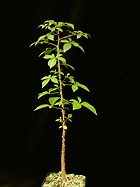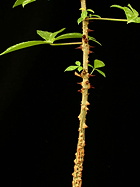This is a majestic tropical tree to 50 m with stout buttressed trunks bearing branches armed with conical prickles. Its flowers are off-white to pink and are followed by large oblong fruits that split open to reveal pea-sized seeds embedded in a cottony mass. Of tropical American origin, the tree is now widely cultivated and naturalized throughout the tropics.
The species has a long and varied history of use. The wood is soft, spongy and so not particularly useful as timber, but whole trunks can be hollowed out for dugout canoes with a capacity for 40 or more people. The cotton surrounding the seeds is known as kapok and is useful for pillow stuffing. One of the more intriguing uses involves the buttresses, slices of which are large enough to be mounted on hinges and used as doors.
One use that has not as yet been widely realized is as a container specimen in succulent collections—the plant is sufficiently drought tolerant and prickly enough to look the part. Containment will keep the growth to a reasonable size, and, as with the related Chorisia, the swollen roots can be gradually exposed as a caudex. One problem that might be encountered is the susceptibility of thin-leaved plants such as Ceiba to spider-mite infestation. Growing outdoors (where temperatures permit) with ample ventilation is usually sufficient to eliminate this problem, but if necessary, spraying with ultra-fine oil insecticide is also effective. HBG 91543, from seed collected Mar 2004, by Joseph P Simcox (JP 4301), in the Xalapan Dist. of Oaxaca, Mexico. $10.
This was erroneously distributed as Ceiba pentandra, a much larger tropical species with massive, buttressed roots. Ceiba aesculifolia subsp. parviflora is a small tree from southern Mexico and has a trunk studded with impressive, corky prickles up to 2" long.

Published in the Cactus and Succulent Journal, Vol. 77 (2), March - April, 2005

